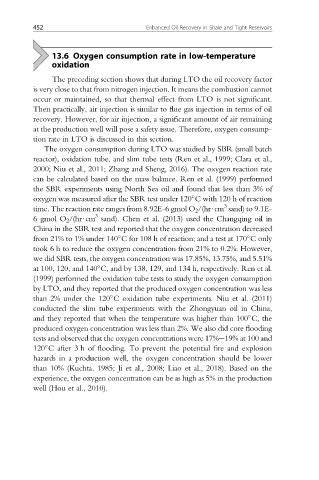Page 488 - Enhanced Oil Recovery in Shale and Tight Reservoirs
P. 488
452 Enhanced Oil Recovery in Shale and Tight Reservoirs
13.6 Oxygen consumption rate in low-temperature
oxidation
The preceding section shows that during LTO the oil recovery factor
is very close to that from nitrogen injection. It means the combustion cannot
occur or maintained, so that thermal effect from LTO is not significant.
Then practically, air injection is similar to flue gas injection in terms of oil
recovery. However, for air injection, a significant amount of air remaining
at the production well will pose a safety issue. Therefore, oxygen consump-
tion rate in LTO is discussed in this section.
The oxygen consumption during LTO was studied by SBR (small batch
reactor), oxidation tube, and slim tube tests (Ren et al., 1999; Clara et al.,
2000; Niu et al., 2011; Zhang and Sheng, 2016). The oxygen reaction rate
can be calculated based on the mass balance. Ren et al. (1999) performed
the SBR experiments using North Sea oil and found that less than 3% of
oxygen was measured after the SBR test under 120 Cwith120 hofreaction
3
time. The reaction rate ranges from 8.92E-6 gmol O 2 /(hr$cm sand) to 9.1E-
3
6gmol O 2 /(hr$cm sand). Chen et al. (2013) used the Changqing oil in
China in the SBR test and reported that the oxygen concentration decreased
from 21% to 1% under 140 C for 108 h of reaction; and a test at 170 Conly
took 6 h to reduce the oxygen concentration from 21% to 0.2%. However,
we did SBR tests, the oxygen concentration was 17.85%, 13.75%, and 5.51%
at 100, 120, and 140 C, and by 138, 129, and 134 h, respectively. Ren et al.
(1999) performed the oxidation tube tests to study the oxygen consumption
by LTO, and they reported that the produced oxygen concentration was less
than 2% under the 120 C oxidation tube experiments. Niu et al. (2011)
conducted the slim tube experiments with the Zhongyuan oil in China,
and they reported that when the temperature was higher than 100 C, the
produced oxygen concentration was less than 2%. We also did core flooding
tests and observed that the oxygen concentrations were 17%e19% at 100 and
120 C after 3 h of flooding. To prevent the potential fire and explosion
hazards in a production well, the oxygen concentration should be lower
than 10% (Kuchta. 1985; Ji et al., 2008; Liao et al., 2018). Based on the
experience, the oxygen concentration can be as high as 5% in the production
well (Hou et al., 2010).

